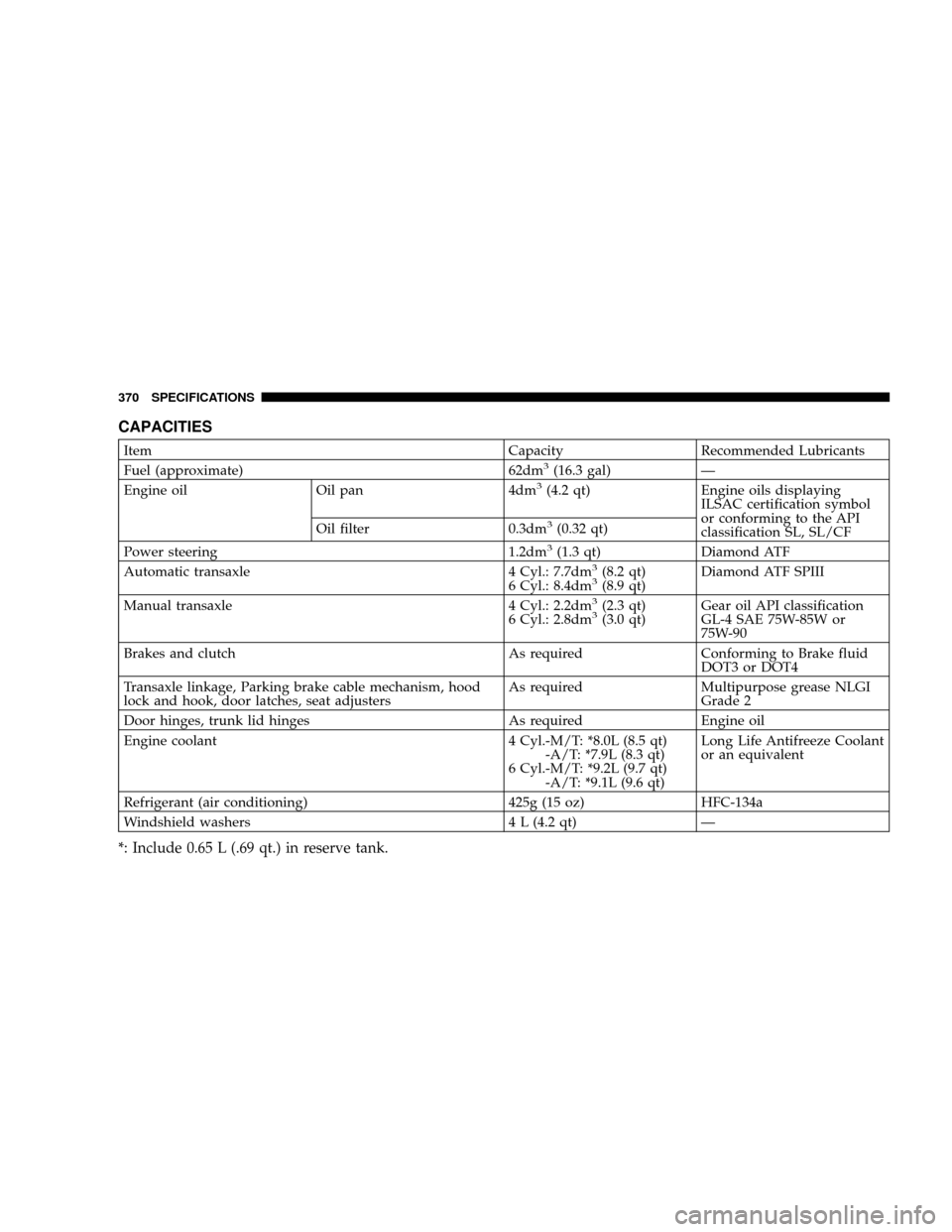Page 245 of 388

To keep the windshield and door windows defogged,
and to keep leg area heated (when driving in rain or
snow).
1. Set the mode selection dial to the
position.
2. Adjust the blower to the desired speed.
3. Set the desired temperature.
For quick defrosting
1. Set the mode selection dial to the
position.
2. Adjust the blower to the maximum blower speed.
3. Adjust the temperature control to the maximum tem-
perature.
NOTE
1. When the mode selection dial is set to the ªº
or ª
º position, the air conditioning compressor will
operate automatically. The outside air position will also
be selected automatically. (In this case, the air condition-
ing indicator will not change.)
2. While in ª
ºorªº position, you cannot turn the
air conditioning off or select the recirculation position.
This ensures that the windows will not fog up.
3. To defog effectively, direct the air flow from the side
vents toward the door windows.
4. When defrosting, do not set the temperature control
dial around the max. cool position. Cool air will blow
against the window glass and fog it up.
H03D1500
FOR PLEASANT DRIVING 245
6
Page 246 of 388
Combination of unheated air and heated air
Set the mode selection dial to the position shown in the
illustration and set the air selection switch (A) to the
outside position.
The air will be directed to the leg area and the upper part
of the passenger compartment. Select the desired blower
speed.
Warm air flows to the leg area and unheated or slightly
warm air flows to the upper part of the passenger
compartment.
Cooling
Set the mode selection dial to the ªº position shown in
the illustration.
Set the air selection switch (A) to the outside position and
push the air conditioning switch (B).
1. Setting for ordinary cooling
2. Setting for cooling the leg area
H03C0680H04F0970
246 FOR PLEASANT DRIVING
Page 247 of 388

Adjust the temperature by turning the temperature con-
trol dial clockwise or counterclockwise.
Select the desired blower speed.
NOTE: If the outside air is dusty or otherwise contami-
nated, or if maximum cooling performance is desired, set
air selection switch (A) to the recirculation position and
the temperature control dial all the way to the left.
Introduce outside air from time to time for proper
ventilation.
Important operation tips for air conditioning
1. Park the vehicle in the shade whenever possible.
Parking under the hot sun makes the vehicle interior
extremely hot, which requires more time to cool the
interior. If it is necessary to park in the sun, open the
windows for the first few minutes of air conditioning
operation to expel hot air.
2. Close the windows when the air conditioning is in use.
The entry of outside air through open windows will
reduce cooling efficiency.
3. When operating the system, make sure the air intake,
which is located in front of the windshield, is free of
obstructions such as leaves. Leaves collected in the
air-intake plenum may reduce air flow and plug the
plenum water drains.
Air conditioning system refrigerant and lubricant
recommendations
If the air conditioning seems less effective than usual, the
cause might be a refrigerant leak.
Have the system inspected by your authorized dealer.
H04F0980
FOR PLEASANT DRIVING 247
6
Page 248 of 388

CAUTION!
The air conditioning system in your vehicle must be
charged with the refrigerant HFC-134a and the lubri-
cant SUN-PAG 56.
Use of any other refrigerant or lubricant will cause
severe damage which will result in the need to
replace your vehicle's entire air conditioning system.
The release of refrigerant into the atmosphere is not
recommended.
The new refrigerant (HFC-134a) in your vehicle is
designed not to harm the earth's ozone layer. How-
ever, it may slightly contribute to global warming.
It is recommended that the refrigerant be recovered
and recycled for future use.
During a long period of disuse
The air conditioning should be operated for at least five
minutes each a week, even in cold weather. This is to
maintain lubrication of the compressor internal parts and
maintain the air conditioning in the best operating con-
dition.
INSTALLATION OF ACCESSORIES
CAUTION!
Before any electrical or electronic accessories are
installed, consult an authorized dealer.
1. Improper installation of an electrical or electronic
accessory may cause a fire or electrical problem.
It also could result in failure of warranty coverage under
the new vehicle limited warranty.
2. When using a communication system such as a cellu-
lar phone or a radio set inside the vehicle, be sure to
install a separate external antenna. When a cellular phone
or a radio set is used by using an internal antenna alone,
it might cause failure to the vehicle's electrical system
and could interfere with safe operation of the vehicle.
248 FOR PLEASANT DRIVING
Page 278 of 388

CAUTION!
²The emergency tire is to be used only temporarily
when the standard tire is damaged. Repair the
damaged tire as soon as possible. Replace the
emergency tire with the standard tire.
²After changing the tire and driving the vehicle
approximately 621 miles (1000 km), retighten the
wheel nuts to make sure that they are not loose.
²If the steering wheel vibrates after changing the
tire, have the tire checked for balance at an autho-
rized dealer.
²Avoid mixing one type of tire with another type or
using tires of a size other than the specified size.
Premature mechanical wear and reduced handling
may result.
ENGINE OVERHEATING
If the engine coolant temperature gauge indicator enters
the ªHº (hot) position, the engine may be overheated.
In any of the following situations, you can reduce the
potential for overheating by taking the appropriate ac-
tion.
²On the highways Ð Slow down.
²In city traffic Ð While stopped, put transaxle in
neutral, but do not increase engine idle speed.
NOTE:There are steps that you can take to slow down
an impending overheat condition. If your air conditioner
is on, turn it off. The air conditioning system adds heat to
the engine cooling system and turning off the A/C
removes this heat. You can also turn the Temperature
control to maximum heat, the Mode control to floor, and
the fan control to High. This allows the heater core to act
as a supplement to the radiator and aids in removing heat
from the engine cooling system.
278 EMERGENCIES
Page 290 of 388
No. Symbol Electrical system Capacity
1
Fuse (+B) 60A
2
Radiator fan motor 50A
3
Anti-lock braking system 60A
4
Ignition switch 40A
5
Electric window controls 30A
6
Fog lights 15A
7Ð Ð Ð
8
Horn 15A
9
Engine control 20A
10
Air conditioning 10A
11
Stop lights 15A
12
ÐÐ
13
Alternator 7.5A
14
Hazard warning flasher 10A
15
Automatic transaxle 20A
16
Headlights high beam (right) 10A
17
Headlights high beam (left) 10A
18
Headlights low beam (right) 10A
19
Headlights low beam (left) 10A
20
Position lights (right) 7.5A
21
Position lights (left) 7.5A
No. Symbol Electrical system Capacity
22
Dome lights 10A
23
Audio 10A
24
Fuel pump 15A
25
Defroster 40A
²Some fuses may not be installed on your vehicle. Fuse
application depends on the vehicle model, specifica-
tions, or options.
7.5A BROWN
10A RED
15A LIGHT BLUE
20A YELLOW
30A GREEN
40A GREEN
50A RED
60A YELLOW
290 EMERGENCIES
Page 323 of 388

Radiator cap
The radiator cap must be fully tightened to prevent loss
of coolant and engine damage.
WARNING!
Make sure that the engine is thoroughly cooled
down before removing the radiator cap, otherwise
hot steam or boiling coolant may gush from the filler
port and scald you.
Points to remember
1. Do not overfill the reserve tank.
2. A special radiator cap is used to ensure sealing and to
allow the coolant to return from the reserve tank to the
radiator when the engine cools. If cap replacement is
necessary, use the proper cap.
3. Check the coolant freeze point in the radiator using
proper instruments, when it is safe to do so. If antifreeze
is added, the contents of the reserve tank must be
protected against freezing.
4. Keep the front of the radiator clean. If your vehicle is
equipped with air conditioning, keep the front of the
condenser clean.5. If the temperature of the engine coolant does not rise
normally after engine warm-up, take the vehicle to an
authorized dealer to have the thermostat checked, and
replaced if necessary.
BRAKE FLUID
Recommended brake fluid conforming to DOT 3 or DOT 4
should be used. The reservoir cap must be fully tightened
to avoid contamination from foreign matter or moisture.
CAUTION!
²Do not allow petroleum-based fluid to contact,
mix with, or otherwise contaminate the brake
fluid. Seal damage will result.
²Take care in handling brake fluid as it may cause
damage to painted surfaces.
²Use only the specified brake fluid. Also, the
additives in different brands may result in a
chemical reaction when mixed together, so avoid
mixing different brands if possible.
²Keep the reservoir tank cap closed to prevent the
brake fluid from evaporating or absorbing moisture.
MAINTENANCE 323
9
Page 370 of 388

CAPACITIES
Item Capacity Recommended Lubricants
Fuel (approximate) 62dm3(16.3 gal) Ð
Engine oil Oil pan 4dm3(4.2 qt) Engine oils displaying
ILSAC certification symbol
or conforming to the API
classification SL, SL/CF Oil filter 0.3dm
3(0.32 qt)
Power steering 1.2dm
3(1.3 qt) Diamond ATF
Automatic transaxle 4 Cyl.: 7.7dm3(8.2 qt)
6 Cyl.: 8.4dm3(8.9 qt)Diamond ATF SPIII
Manual transaxle 4 Cyl.: 2.2dm3(2.3 qt)
6 Cyl.: 2.8dm3(3.0 qt)Gear oil API classification
GL-4 SAE 75W-85W or
75W-90
Brakes and clutch As required Conforming to Brake fluid
DOT3 or DOT4
Transaxle linkage, Parking brake cable mechanism, hood
lock and hook, door latches, seat adjustersAs required Multipurpose grease NLGI
Grade 2
Door hinges, trunk lid hinges As required Engine oil
Engine coolant 4 Cyl.-M/T: *8.0L (8.5 qt)
-A/T: *7.9L (8.3 qt)
6 Cyl.-M/T: *9.2L (9.7 qt)
-A/T: *9.1L (9.6 qt)Long Life Antifreeze Coolant
or an equivalent
Refrigerant (air conditioning) 425g (15 oz) HFC-134a
Windshield washers 4 L (4.2 qt) Ð
*: Include 0.65 L (.69 qt.) in reserve tank.
370 SPECIFICATIONS